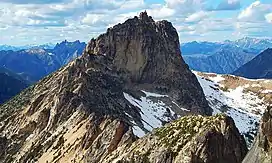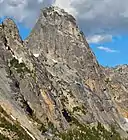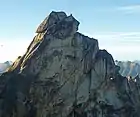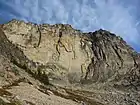Big Kangaroo
Big Kangaroo is an 8,280+ ft (2,520+ m) granitic mountain located in Okanogan County, Washington. The mountain is part of the Methow Mountains in the Cascade Range. Big Kangaroo is the high point of Kangaroo Ridge which is about two miles east and within view of Washington Pass. Its nearest higher peak is Snagtooth Ridge, 1.7 mi (2.7 km) to the northeast.[1] Precipitation runoff from the peak drains into Early Winters Creek which is a tributary of the Methow River.
| Big Kangaroo | |
|---|---|
 Big Kangaroo seen from Wallaby Peak | |
| Highest point | |
| Elevation | 8,280 ft (2,520 m)[1] |
| Prominence | 1,000 ft (300 m)[1] |
| Coordinates | 48°31′09″N 120°37′03″W |
| Geography | |
 Big Kangaroo Location in Washington | |
| Location | Okanogan County, Washington |
| Parent range | Cascade Range |
| Topo map | USGS Silver Star Mountain |
| Geology | |
| Age of rock | 45 million years old |
| Type of rock | (Rapakivi texture) granite |
| Climbing | |
| First ascent | brothers Helmy and Fred Beckey, Walt Varney, June 21, 1942[2] |
Climate
Big Kangaroo is located in the marine west coast climate zone of western North America.[2] Most weather fronts originate in the Pacific Ocean, and travel northeast toward the Cascade Mountains. As fronts approach the North Cascades, they are forced upward by the peaks of the Cascade Range, causing them to drop their moisture in the form of rain or snowfall onto the Cascades. As a result, the west side of the North Cascades experiences high precipitation, especially during the winter months in the form of snowfall.[2] During winter months, weather is usually cloudy, but, due to high pressure systems over the Pacific Ocean that intensify during summer months, there is often little or no cloud cover during the summer.[2] Because of maritime influence, snow tends to be wet and heavy, resulting in high avalanche danger.[2]
Geology
The North Cascades features some of the most rugged topography in the Cascade Range with craggy peaks, ridges, and deep glacial valleys. Geological events occurring many years ago created the diverse topography and drastic elevation changes over the Cascade Range leading to the various climate differences. These climate differences lead to vegetation variety defining the ecoregions in this area.
The history of the formation of the Cascade Mountains dates back millions of years ago to the late Eocene Epoch.[3] With the North American Plate overriding the Pacific Plate, episodes of volcanic igneous activity persisted.[3] In addition, small fragments of the oceanic and continental lithosphere called terranes created the North Cascades about 50 million years ago.[3]
During the Pleistocene period dating back over two million years ago, glaciation advancing and retreating repeatedly scoured the landscape leaving deposits of rock debris.[3] The "U"-shaped cross section of the river valleys are a result of recent glaciation. Uplift and faulting in combination with glaciation have been the dominant processes which have created the tall peaks and deep valleys of the North Cascades area.
See also
Gallery
- The peaks of Kangaroo Ridge
 Washington Pass view of Kangaroo Ridge
Washington Pass view of Kangaroo Ridge Kangaroo Temple
Kangaroo Temple The Fin and The Tomahawk
The Fin and The Tomahawk Melted Tower
Melted Tower
 Joey (left) and Big Kangaroo
Joey (left) and Big Kangaroo "Joey" 8183'
"Joey" 8183' Summit of Big Kangaroo
Summit of Big Kangaroo Big Kangaroo's south face
Big Kangaroo's south face Big Kangaroo viewed from Washington Pass
Big Kangaroo viewed from Washington Pass
References
- "Big Kangaroo, Washington". Peakbagger.com.
- Beckey, Fred W. (2009). Cascade Alpine Guide: climbing and high routes, Vol. 3, Rainy Pass to Fraser River (3rd ed.). Mountaineers Books. p. 302. ISBN 978-1-59485-136-0.
- Kruckeberg, Arthur (1991). The Natural History of Puget Sound Country. University of Washington Press.